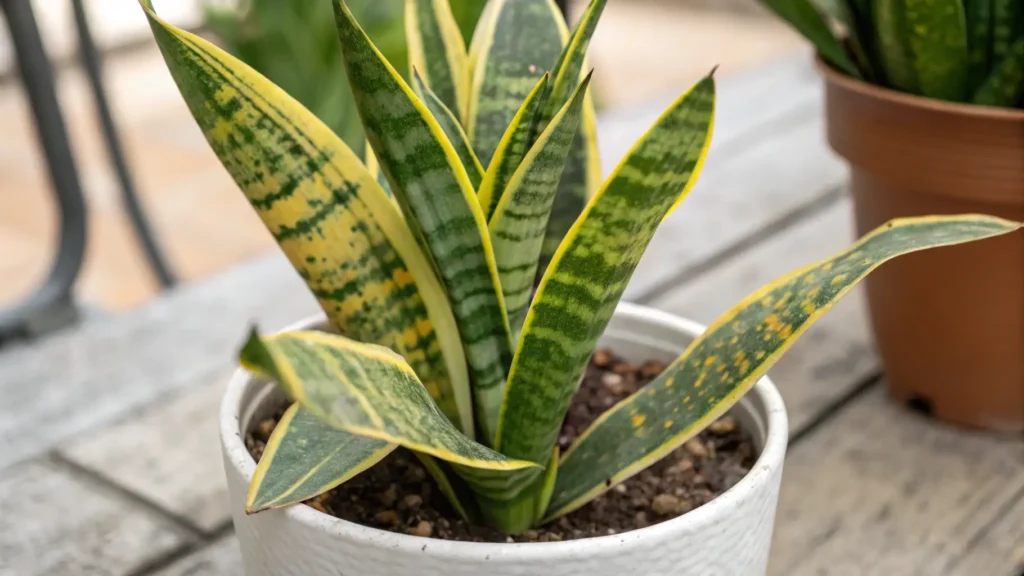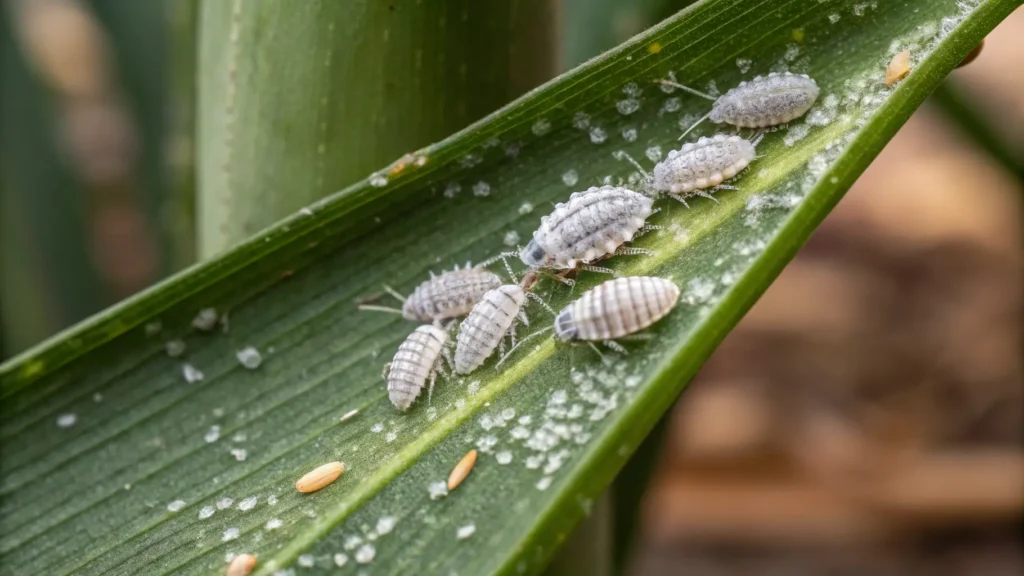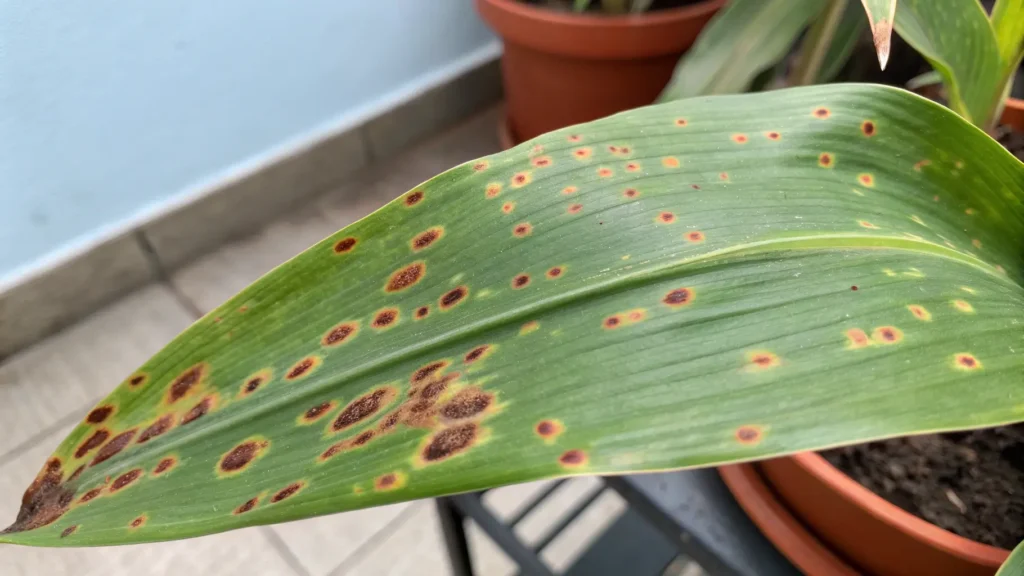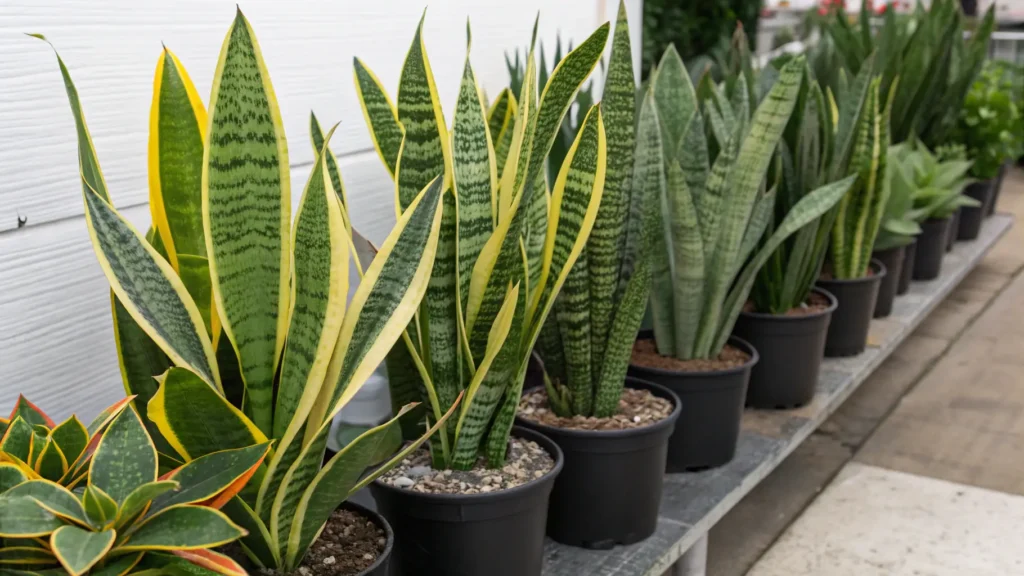Imagine a houseplant that thrives on neglect, purifies your air, and adds a touch of modern elegance to any room. That’s the magic of the snake plant, or Sansevieria. Whether you’re a seasoned plant parent or just starting your green journey, mastering snake plant care is simpler than you think. This definitive guide will transform your approach, empowering you to cultivate vibrant, healthy Sansevieria plants that become the envy of all.

TABLE OF CONTENTS
Snake Plants: Why They’re Perfect for Every Home
Snake plants, scientifically known as Sansevieria trifasciata (and often referred to as Mother-in-law’s Tongue), are among the most resilient and popular houseplants globally. Originating from the dry, rocky regions of West Africa, their ability to withstand harsh conditions makes them incredibly adaptable to indoor environments.
Beyond their striking, upright foliage that brings architectural flair to any space, snake plants offer significant benefits. They are renowned for their air-purifying qualities, famously cited in the NASA Clean Air Study for removing toxins like formaldehyde and benzene from indoor air. This unique combination of aesthetic appeal, air purification, and incredibly low maintenance makes them perfect for both beginners and experienced plant enthusiasts. Our stunning opening visual showcases the incredible transformation a well-cared-for Sansevieria can undergo, proving why a surprising 50 million households worldwide boast at least one of these incredible plants.
7 Great Snake Plant Benefits Proven In Research & Studies
Essential Snake Plant Care: Foundations for a Thriving Sansevieria
Achieving a thriving Sansevieria begins with understanding its fundamental needs. This section merges comprehensive basic snake plant care with beginner-friendly clarity, laying the groundwork for your plant’s success.
Light Requirements
Snake plants are incredibly versatile when it comes to light, tolerating a wide range of conditions.
- Ideal Light: Bright, indirect light is optimal for vigorous growth and vibrant variegation. Place them near a north-facing window, or a few feet away from an east, west, or south-facing window.
- Low Light Toleration: They can survive in low-light conditions, making them excellent choices for dimly lit rooms or offices. However, growth will slow significantly, and variegation might become less pronounced.
- Signs of Too Much Light: Scorched or bleached leaves, often with dry, crispy edges.
- Signs of Too Little Light: Darker green leaves (losing variegation), leggy growth, or a complete halt in growth.
Watering Guide
Overwatering is the number one killer of snake plants. Less is definitely more.
- The “Bottom-Up” Watering Method: This is ideal to prevent waterlogging. Place your potted plant in a tray of water for 20-30 minutes, allowing the soil to wick up moisture.
- How Often: Allow the soil to dry out completely between waterings. This typically means every 2-4 weeks, but varies seasonally. Water less frequently in winter (dormant period) and more often in warmer, brighter months.
- Signs of Overwatering: Mushy, yellowing leaves, soft stems, and a foul odor (indicating root rot).
- Signs of Underwatering: Crispy leaf tips, curling leaves, or a slightly wrinkled appearance.
Soil & Potting Perfection
The right foundation is crucial for healthy Sansevieria growth.
- Importance of Well-Draining Soil: Snake plants are succulents and are highly susceptible to root rot if their roots sit in soggy soil.
- Ideal Soil Mix: A well-draining cactus or succulent potting mix is perfect. You can also create your own by mixing regular potting soil with perlite or pumice (2:1 or 1:1 ratio) for improved drainage.
- Pot Material: Terracotta pots are excellent as they are porous and allow excess moisture to evaporate, preventing root rot. Plastic pots retain more moisture, so adjust your watering frequency accordingly.
- Drainage Holes: Always choose a pot with drainage holes. Without them, water will accumulate at the bottom, leading to root rot.
Temperature & Humidity
Snake plants are generally unfussy about temperature and humidity.
- Optimal Indoor Conditions: They thrive in typical room temperatures between 65-80°F (18-27°C).
- What to Avoid: Keep them away from cold drafts, open windows in winter, and extreme temperature fluctuations, which can shock the plant. They do not require high humidity and perform well in average household humidity.
Fertilizing Your Snake Plant
Snake plants are light feeders and don’t require much fertilizer.
- When and How Often: Fertilize sparingly, typically once or twice during the growing season (spring and summer). Avoid fertilizing in fall and winter.
- Type of Fertilizer: Use a balanced, all-purpose liquid houseplant fertilizer diluted to half strength. Too much fertilizer can burn the roots.
Advanced Snake Plant Propagation: Expand Your Collection with Confidence
Propagation is a rewarding way to multiply your Sansevieria collection or save a struggling plant. This section dives deep into various methods, providing expert-level detail that ensures your success.
Why and When to Propagate
- Reasons for Propagation: Create new plants for friends, fill out a sparse pot, save a plant suffering from root rot, or rejuvenate an old, leggy plant.
- Ideal Timing: The best time for propagation is during the active growing season, typically spring or early summer, when plants have more energy to root and grow.
Understanding Snake Plant Anatomy for Propagation
Successful propagation hinges on understanding key structures.
- Leaves: Mature, healthy leaves are commonly used for cuttings.
- Rhizomes: These are underground stems from which new shoots and roots emerge. Division of rhizomes is best for mature, clump-forming plants.
- Pups: Small, new plants that grow from the base of the mother plant, connected by rhizomes.
Method 1: Leaf Cuttings in Water (Step-by-Step)
This is a popular and visually satisfying method.
- Select a Healthy Leaf: Choose a firm, mature leaf.
- Cut into Sections: Using sterilized scissors or a knife, cut the leaf into 2-4 inch sections. Mark the bottom end of each section to ensure proper orientation during rooting.
- Allow to Callus: Let the cuttings air dry for 2-3 days until the cut end forms a callus. This prevents rot.
- Place in Water: Submerge the callused end about an inch deep in a jar of clean water.
- Monitor & Change Water: Place in bright, indirect light. Change the water every few days to keep it fresh and prevent bacterial growth.
- Root Development: Roots typically appear in 4-8 weeks, followed by new plantlets (pups) in another 1-2 months.
- Transplant: Once roots are a few inches long and a pup forms, transplant into well-draining soil.
172 Days in 62s – Growing a Snake Plant from Cutting in TIMELAPSE
Method 2: Leaf Cuttings in Soil (Step-by-Step)
This method often results in stronger initial plants.
- Prepare Cuttings: Follow steps 1-3 from the water propagation method.
- Soil Preparation: Fill a small pot with a well-draining cactus/succulent mix.
- Plant Cuttings: Insert the callused end of each cutting about 1 inch deep into the soil. For optimal success, you can dip the cut end in rooting hormone.
- Water Lightly: Water lightly after planting, then only when the soil is completely dry.
- Provide Warmth & Light: Place in a warm spot with bright, indirect light.
- Patience is Key: Rooting and pup formation can take 6-12 weeks or longer. Gently tugging on the cutting will indicate if roots have formed (resistance).
Method 3: Rhizome Division for Mature Plants (Step-by-Step)
This is the fastest way to get new, large plants.
- Remove Plant: Carefully remove the entire snake plant from its pot.
- Identify Divisions: Gently shake off excess soil to expose the rhizomes and roots. Identify natural divisions or “clumps” of leaves with their own root systems.
- Separate Sections: Using a clean, sharp knife, carefully cut through the rhizomes to separate the desired sections. Ensure each new section has at least a few leaves and a healthy root system.
- Allow to Callus (Optional but Recommended): Let the cut surfaces air dry for 1-2 days to prevent rot, especially for larger divisions.
- Repot: Plant each new division into its own pot with fresh, well-draining soil.
Tips for Propagation Success
- Light & Temperature: Provide bright, indirect light and maintain consistent warm temperatures (70-80°F or 21-27°C).
- Humidity: While not strictly necessary, slightly higher humidity can be beneficial.
- Sterilizing Tools: Always sterilize your cutting tools with rubbing alcohol before and after use to prevent disease transmission.
- Rooting Hormone: While not essential, rooting hormone can significantly increase success rates and speed up the process, especially for soil cuttings.
Common Propagation Mistakes & Solutions
- Rotting Cuttings: This is usually due to too much moisture or insufficient callusing. Ensure soil dries completely, change water regularly, and always callus cuttings.
- Slow Rooting: Patience is vital. Ensure optimal light and temperature. Some varieties take longer.
- Failed Attempts: Don’t get discouraged! Re-evaluate your technique, ensure tools are sterilized, and try again with fresh cuttings.
Aftercare for New Snake Plant Cuttings
Once your cuttings have rooted and developed pups:
- Transplanting Rooted Cuttings: Gently move water-rooted cuttings to a well-draining soil mix once roots are a few inches long.
- Initial Post-Propagation Care: Water lightly, then allow soil to dry completely. Provide bright, indirect light. Treat them as young, vulnerable plants for the first few months.
Our Unique Angle: Download our exclusive Propagation Success Checklist to guide you through each step. As renowned horticulturist Dr. Elaine Merritt often says, “The secret to robust rooting isn’t just moisture, but consistent warmth and adequate light for the plant’s metabolic processes to activate.”
Repotting Your Snake Plant: When, Why, and How
Repotting is a vital aspect of snake plant care to ensure continued growth and health.
Signs Your Snake Plant Needs Repotting
- Root-Bound: Roots are growing out of the drainage holes or circling tightly around the inside of the pot.
- Stunted Growth: The plant has stopped growing or growth is noticeably slow, even during the growing season.
- Pot Damage: The pot is bulging, cracking, or breaking due to root pressure.
- Top-Heavy: The plant is becoming unstable and prone to tipping over.
Choosing the Right Pot Size and Material
- Pot Size: Generally, go up only one pot size (e.g., from a 6-inch to an 8-inch pot). Snake plants prefer to be slightly root-bound. Too large a pot can retain excess moisture, leading to root rot.
- Pot Material: Terracotta or unglazed ceramic pots are recommended for their breathability, which helps prevent overwatering.
Step-by-Step Repotting Process with Images
- Gather Supplies: New pot, fresh well-draining soil, sterilized cutting tools (if needed), gloves.
- Prepare the Pot: Add a layer of fresh soil to the bottom of the new pot.
- Remove the Plant: Gently tip the old pot on its side and carefully slide the plant out. You may need to loosen the root ball with your fingers.
- Inspect Roots: Examine the roots for any signs of rot (mushy, black roots). Trim off any unhealthy roots with sterilized scissors. You can also gently tease apart the root ball if it’s very dense.
- Position the Plant: Place the snake plant in the new pot, ensuring the base of the plant is at the same level as it was in the old pot, or slightly lower.
- Add Soil: Fill the pot with fresh soil, gently tamping it down to remove large air pockets. Leave about an inch of space from the rim.
- Water Lightly: Water the plant lightly to help the soil settle.
Post-Repotting Care
- Light: Place the newly repotted plant in a spot with bright, indirect light.
- Watering: Wait about a week before the first thorough watering to allow any disturbed roots to heal. Resume your regular watering schedule once the soil is completely dry.
- Fertilizer: Avoid fertilizing for at least 4-6 weeks after repotting to prevent root burn.
Troubleshooting Common & Advanced Snake Plant Problems: Diagnose and Revive
Even resilient snake plants can encounter issues. This in-depth troubleshooting guide will help you identify, diagnose, and resolve common and advanced snake plant problems, ensuring you can revive your beloved Sansevieria.

Yellowing/Browning Leaves
- Overwatering: Most common cause. Soil stays wet, leading to root rot. Solution: Reduce watering frequency, ensure good drainage.
- Underwatering: Less common, but possible. Leaves may also appear crispy. Solution: Increase watering slightly, ensure soil is thoroughly moistened when you do water.
- Nutrient Deficiencies: Rare for snake plants, but can occur in very old soil. Solution: Repot with fresh soil or apply a diluted, balanced fertilizer during the growing season.
- Light Issues: Too much direct sun can scorch leaves (browning). Too little light can lead to overall decline. Solution: Adjust placement to provide bright, indirect light.
Drooping/Mushy Leaves
- Root Rot: The primary cause. Overwatering leads to roots suffocating and decaying. Leaves will feel soft, mushy, and often have a foul odor. Solution: Immediately remove from pot, inspect roots, trim off all rotted sections, allow cuts to callus, and repot in fresh, dry soil. Do not water for a week.
- Cold Damage: Exposure to very cold temperatures or drafts can cause leaves to become soft and droop. Solution: Move the plant to a warmer location, away from windows or vents in winter.
Pest Identification & Treatment
Snake plants are generally pest-resistant, but issues can arise.
- Spider Mites: Tiny, reddish-brown mites that create fine webbing. Solution: Isolate plant, wipe leaves with a damp cloth, use neem oil or insecticidal soap.
- Mealybugs: Small, white, cottony insects found in leaf axils or on stems. Solution: Dab with rubbing alcohol on a cotton swab, use neem oil, or insecticidal soap.
- Thrips: Tiny, slender insects that feed on sap, causing silvery streaks or distorted new growth. Solution: Isolate, prune affected leaves, use neem oil or systemic insecticides for severe infestations.

Fungal & Bacterial Diseases
- Leaf Spot: Dark, circular spots on leaves, often caused by overwatering or high humidity. Solution: Improve air circulation, reduce watering, remove affected leaves.
- Rust: Orange or reddish-brown pustules, typically on the undersides of leaves. Solution: Improve air circulation, avoid overhead watering, remove affected leaves.
- Prevention: The best defense is proper snake plant care, avoiding overwatering, and ensuring good air circulation.

Environmental Stressors
- Cold Shock: Sudden exposure to cold temperatures can damage tissues. Solution: Maintain consistent room temperatures above 50°F (10°C).
- Heat Stress: While tolerant, extreme heat can cause leaves to wilt or become pale. Solution: Ensure good air circulation, move away from direct, intense heat sources.
- Physical Damage: Accidental bumps or falls can bruise or break leaves. Solution: Handle with care, place in a secure location.
Why Your Snake Plant Isn’t Growing
- Insufficient Light: While they tolerate low light, they won’t grow much. Solution: Move to a brighter spot with indirect light.
- Overwatering/Root Rot: Inhibits nutrient uptake. Solution: Check for rot, adjust watering.
- Lack of Nutrients: Rarely, very old soil can be depleted. Solution: Repot or fertilize sparingly.
- Dormancy: Snake plants naturally slow down growth in fall and winter. This is normal.
Discovering Snake Plant Varieties: Beyond the Basic Green
While the classic green Sansevieria trifasciata is well-known, the world of snake plants is incredibly diverse and fascinating. Explore these stunning snake plant varieties to expand your collection.

Popular Sansevieria Varieties
- ‘Laurentii’: The iconic variety with dark green leaves featuring striking golden-yellow margins.
- ‘Zeylanica’: Dark green leaves with lighter green, horizontal, wavy bands. A classic, upright grower.
- ‘Moonshine’: Features silvery-green leaves, sometimes with faint darker banding, developing dark green edges as it matures.
- ‘Cylindrica’: Characterized by its round, stiff, deep green leaves that often grow in a fan shape. Also known as African Spear.
- ‘Fernwood’ (Mikado): A hybrid between S. cylindrica and S. trifasciata, featuring slender, cylindrical leaves with darker green bands.
Rare & Unique Cultivars
- ‘Whitney’: A striking dwarf variety with very dark green, almost black leaves, edged with bright green.
- ‘Black Gold’: Similar to ‘Laurentii’ but with much darker, almost black leaves contrasted by intense golden-yellow margins.
- ‘Starfish’ (Boncellensis): Features unique, chunky, cylindrical leaves that grow in a fan-like, star-shaped pattern.
- ‘Hahnii’ (Bird’s Nest): A dwarf variety that grows in a compact, rosette shape resembling a bird’s nest, often variegated.
Identification Guide
Key visual differences in snake plant varieties include:
- Leaf Shape: Flat, sword-like (trifasciata), cylindrical (cylindrica, ‘Starfish’), or rosette-forming (‘Hahnii’).
- Color & Variegation: Shades of green, silvery-green, dark green, and vibrant yellow or cream margins or banding.
- Growth Habit: Upright and tall, or short and compact.
Care Nuances for Specific Varieties
Most varieties share similar Sansevieria care needs, but some subtle differences exist:
- Variegated Varieties: (‘Laurentii’, ‘Moonshine’, ‘Black Gold’) often prefer slightly brighter indirect light to maintain their vibrant coloration. In very low light, their variegation can fade.
- Dwarf Varieties: (‘Hahnii’, ‘Whitney’) may require less frequent watering due to their smaller size and pot volume.
Our Unique Angle: Explore our stunning visual gallery of 20+ snake plant varieties with high-resolution, professional photography. Check out our Variety Comparison Chart highlighting unique features, growth patterns, and care nuances.
Beyond Aesthetics: The Health Benefits & Safety of Snake Plants
Snake plants are more than just beautiful décor; they offer tangible health benefits and are incredibly resilient. However, understanding their potential toxicity is crucial.
Air Purification Claims
The most widely cited benefit of snake plants is their ability to purify indoor air.
- NASA Clean Air Study: This landmark study identified the snake plant as highly effective at removing several volatile organic compounds (VOCs) including formaldehyde, benzene, trichloroethylene, and xylene from the air.
- Nighttime Oxygen Production: Unlike most plants, Sansevieria performs Crassulacean Acid Metabolism (CAM), meaning they open their stomata and release oxygen at night, making them ideal bedroom plants.
Low Maintenance and Resilience Benefits
- Drought Tolerant: Their succulent leaves store water, allowing them to withstand long periods without watering.
- Pest Resistant: Generally less prone to pests compared to many other houseplants.
- Adaptable: They adapt well to a wide range of light, temperature, and humidity conditions.
Is the Snake Plant Toxic? (Detailed Answer on Pet and Child Safety)
Yes, the snake plant is considered mildly toxic if ingested by humans or pets.
- Toxic Compounds: It contains saponins, which can cause gastrointestinal upset.
- Common Symptoms of Ingestion (Pets): Vomiting, diarrhea, nausea, and drooling. The severity depends on the amount ingested.
- Common Symptoms of Ingestion (Humans): Minor mouth and throat irritation, potential nausea.
- Safety for Children: Keep out of reach of small children who might be tempted to put leaves in their mouths.
- Safety for Pets: Place plants in areas inaccessible to curious pets, especially cats and dogs.
Safe Placement and Handling Tips
- High Shelves: Ideal for homes with pets or small children.
- Secure Locations: Ensure pots are stable and won’t be easily knocked over.
- Wash Hands: After handling the plant, especially if you’ve broken a leaf, wash your hands.
Our Unique Angle: A concise, shareable infographic on “5 Surprising Benefits of Snake Plants.” Dr. Sarah Jenkins, a veterinary toxicologist, advises, “While snake plants are mildly toxic, serious harm from ingestion is rare. The bitter taste often deters pets before they consume enough to cause severe illness. Still, prevention through careful placement is key.”
Expert Tips & Advanced Insights for Long-Term Sansevieria Health
Elevate your snake plant care with these expert insights and ensure your Sansevieria thrives for years to come.
Seasonal Care Adjustments (Winter vs. Summer)
- Winter: Reduce watering significantly. Your plant is dormant and requires less moisture. Ensure it’s away from cold drafts. No fertilization.
- Summer: This is the active growing season. Increase watering frequency (still allowing soil to dry), and fertilize sparingly.
Cleaning Leaves for Optimal Photosynthesis
Dust can accumulate on snake plant leaves, blocking light absorption.
- How to Clean: Gently wipe leaves with a soft, damp cloth every few weeks.
- Benefits: Promotes better photosynthesis, enhances plant appearance.
Common Myths About Snake Plant Care Debunked
- Myth: Snake plants need very little light. Reality: While they tolerate low light, they prefer bright, indirect light for optimal growth and variegation.
- Myth: They only need water once a month. Reality: Watering frequency depends on light, temperature, pot size, and soil type. Always check the soil before watering.
Troubleshooting Slow Growth or Lack of Flowers
- Slow Growth: If your plant isn’t growing in adequate light, check for root rot or nutrient deficiency. Remember, they are slow growers naturally.
- Lack of Flowers: Snake plants can flower, but it’s rare indoors. They need very specific, ideal conditions (bright light, consistent warmth, proper watering) to produce their small, fragrant, greenish-white flowers. Don’t worry if yours doesn’t flower; it’s a sign of a very happy plant, not poor care.
Integrating Snake Plants into Home Decor
Their upright, architectural form makes snake plants perfect for:
- Modern Aesthetics: Use them in minimalist spaces for a clean, sculptural look.
- Verticality: Their tall growth adds height to plant arrangements.
- Corners & Entryways: Ideal for filling empty spaces or making a grand statement.
Our Unique Angle: Discover “Top 7 Mistakes Even Experienced Plant Owners Make” – a section distilled from years of professional plant grower wisdom and aggregated long-term care data, to truly master your Sansevieria growth.
Snake Plant Care Frequently Asked Questions (FAQs)
Here are answers to the most common questions about snake plant care.
Can a snake plant live in a low-light room?
Yes, snake plants can survive in low-light rooms, making them excellent choices for darker spaces. However, for optimal growth and vibrant color, they prefer bright, indirect light. Growth will be slower in low light.
How fast do snake plants grow?
Snake plants are relatively slow growers, especially indoors. You might see a few new leaves or pups emerge each year, with faster growth occurring in spring and summer under ideal conditions.
Do snake plants flower?
Yes, snake plants can flower, but it’s quite rare for them to do so indoors. When they do, they produce tall spikes with small, fragrant, greenish-white flowers. This usually happens under perfect light and care conditions.
What are the brown tips on my snake plant?
Brown tips on snake plant leaves are often caused by inconsistent watering (either too much or too little), low humidity, or a buildup of salts from fertilizer. Ensure consistent, proper watering and consider distilled water if your tap water is very hard.
Can snake plants be kept outdoors?
Snake plants can be kept outdoors in warm climates (USDA Zones 9-11) where temperatures don’t drop below 50°F (10°C). They thrive in partial shade. Bring them indoors if temperatures are expected to fall.
Why are my snake plant leaves drooping?
Drooping or mushy leaves on a snake plant are almost always a sign of overwatering and root rot. Immediately check the roots, trim any rotted sections, and repot in fresh, dry soil. Adjust your watering schedule to allow the soil to dry completely between waterings.
Conclusion: Your Journey to Mastering Snake Plant Care
You now have the definitive guide to mastering snake plant care, equipping you with the knowledge to cultivate robust and beautiful Sansevieria plants. We’ve covered everything from essential watering techniques and advanced propagation methods to comprehensive troubleshooting and identifying unique varieties. Remember the core principles: infrequent watering, well-draining soil, and bright, indirect light.
With these expert insights, you’re not just growing a plant; you’re nurturing a resilient, air-purifying companion that enhances your home. We’re confident you’ll achieve unparalleled success with your Sansevieria. Share your success stories with our community, and download your free, personalized “Snake Plant Care Quick Reference Card” to keep these vital tips at your fingertips. Your journey to exceptional snake plant care starts now!
